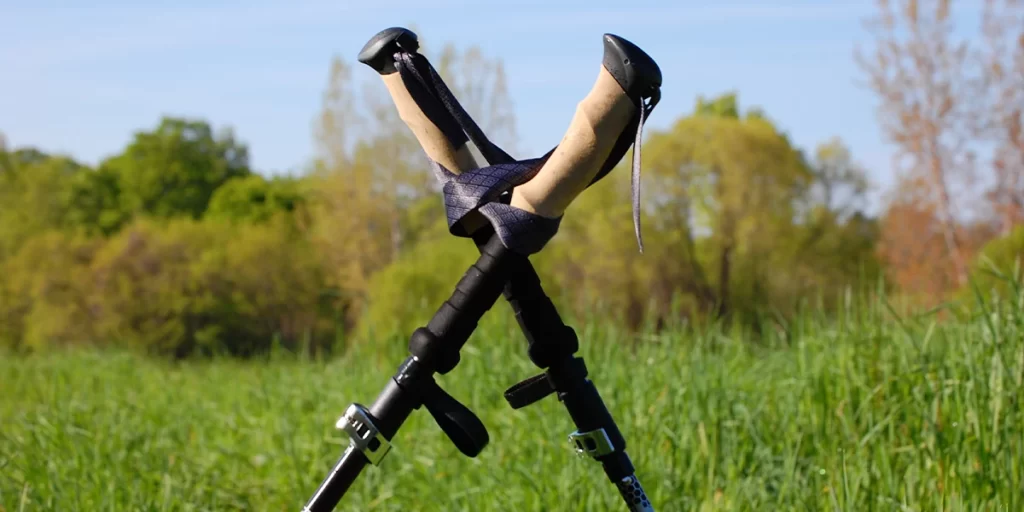

Have you ever wondered how some hikers effortlessly walk up really steep mountain trails when you have to work really hard just to keep from falling? The secret may be in what they carry – trekking poles.
This guide will help you understand the basics of these nifty hiking accessories and, most importantly, provide tips on how to choose the trekking poles that will make hiking more fun and less tiring.
Interested? Let’s get started.
Trekking poles come in various designs, and understanding their differences is crucial in finding the right pair. Here are the four main design configurations:
1. 3-Section Telescoping Poles:

This design is popular and effective on different terrains. You can change the length for uphill and downhill parts. They are collapsible and usually measure between ~24 inches (packed) and ~54 inches (fully extended) (61-137cm). Telescoping poles often come with built-in shock absorption, reducing joint strain as you go.
2. Folding Poles:

Folding poles are a relatively new design in the trekking pole market. They are the most compact option in terms of pack size but might not be as durable as telescoping ones. Also, many folding poles lack the adjustability of telescoping poles, offering only 6 to 8 inches (15-20cm) of length adjustment.
3. Fixed-length Poles:

Some poles come in a single, fixed length with no collapsibility or length adjustment. This design reduces weight and adds strength by eliminating adjustment components. Fixed-length poles are ideal for those focused on minimizing kit weight or those who are into trail running. However, as you can imagine, these are challenging to travel with and nearly impossible to bring on a plane.

The material of your trekking pole shafts plays a significant role in their performance and durability. Trekking poles are primarily constructed from two different materials: carbon fiber and aluminum:
Trekking poles offer adjustable features to suit hikers’ preferences and terrain. Knowing these mechanisms is vital when selecting the right poles.
Key adjustment mechanisms include:
The tips at the bottom end of trekking poles play a critical role in traction, durability, and performance on different terrains.
Here are some key things to know about pole tips:
Luckily, many poles allow interchangeable tips that screw into the final pole section. This allows customizing your tips based on current terrain and conditions.
The size of the baskets on your trekking poles affects how well they perform in different terrains and weather conditions.
Here’s what you need to know about basket sizes:
Some trekking poles have interchangeable baskets that allow you to switch between small and large options, providing flexibility for various conditions.
The grip is critical for comfort and control. Understanding ergonomics and materials is key to choosing the right grip.
Grip Shapes
Grip Materials
Hand Straps
Pay attention to the design and material of the hand straps. Look for padded and adjustable straps that distribute the pressure evenly across your hand and wrist. Breathable strap materials like nylon or polyester prevent skin irritation. Leather is always a good premium option.

Now that you’re well-versed in the essential aspects of trekking poles, it’s time to make an informed decision and choose the right pair for your outdoor adventures.
Follow these steps to ensure you select trekking poles that suit your needs:
To make your life a bit easier, here are some popular ultralight trekking pole options:
| Brand / Model | Weight per pole oz (g) |
|---|---|
| Gossamer Gear LT5 Three Piece Carbon Trekking Poles | 4.9 (139) |
| Black Diamond Distance Carbon Z Poles | 5.1 (145) |
| Zpacks Carbon Fiber Trekking Poles | 7.2 (205) |
| Helinox Passport TL130 Adjustable | 5.8 (164) |
| Mountainsmith Andesite Trekking Poles | 5.3 (150) |
In conclusion, trekking poles are extremely helpful for outdoor fans. They offer many benefits like better stability, less joint impact, saving energy, improved balance, and use in different activities.
To pick the right pair, remember it’s important to know about the designs, materials, adjustments, basket sizes, grip comfort, and hand strap styles.
We trust this post was useful. Treat yourself to a new pair of dependable companions and step into the outdoors with confidence. Happy hiking!
Interested? You can also check out our TOP 5 Guide for the lightest trekking poles on the market.
Trekking poles make hiking easier by providing better stability, balance, and shock absorption on rough terrain. They reduce strain on your knees, ankles, and lower back. With four contact points instead of just two feet, they help save energy, making it easier to handle slopes and long distances. Trekking poles also improve posture, offer an upper body workout, and help check depth and ground composition. Whether going uphill, downhill, or crossing streams, these poles enhance traction, support, and safety. Adjustable and lightweight poles, customized to your height and hiking goals, ensure confident navigation and a more enjoyable outdoor experience.
Trekking poles are typically made from either aluminum or carbon fiber, each with its own pros and cons. Aluminum poles are sturdy and can handle pressure and impacts on rough terrain, although they are heavier than carbon. They offer reliability at an affordable cost. On the other hand, carbon fiber poles are super lightweight, provide stiffness and stability when loaded vertically, and dampen vibrations effectively. However, they are pricier than aluminum and may not withstand lateral forces or falls as well. Considering factors like weight, strength, price, and durability will help you choose the right pole material for your hiking needs and budget.
When picking trekking poles, choose adjustable telescoping or folding designs for versatility on different terrains. Check grip and strap ergonomics for a comfortable fit, moisture-wicking, and even pressure distribution to avoid fatigue. Be aware that lever-based adjustments are quicker, while twist locks may get stuck over time. Select basket sizes based on conditions—smaller for dirt or rocks, larger to avoid sinking in mud or snow. Consider durability and capabilities in terms of hiking distance, elevation gain, and off-trail needs. The best poles offer flexibility, comfort, safety, and terrain-specific features like shock absorption and anti-microbial grips, all within your budget. With many factors to consider, seeking expert advice can help find the perfect poles for your hiking preferences and destinations.
When choosing trekking poles, consider the benefits of adjustable and fixed-length options based on your priorities. Adjustable poles, with telescoping or folding designs, offer the flexibility to change length for uphill and downhill terrain, navigating obstacles, and easy storage. They are versatile and suitable for various terrains and activities. On the other hand, fixed-length poles are great for those focused on minimizing weight and maximizing durability, as they eliminate movable parts. However, their lack of adjustability makes them less portable. Most hikers find adjustable poles, offering flexibility and packability without much added weight, to be the best choice. Yet, ultralight backpackers and trail runners may prefer fixed-length simplicity for gram savings, sacrificing some convenience. Knowing your needs helps strike the right balance between adjustability and minimalism.